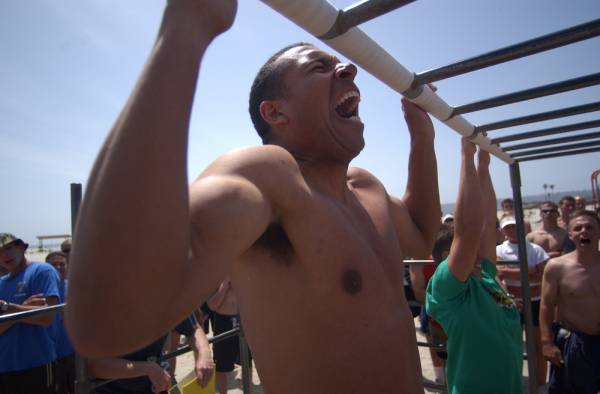Click Here to Start Stew’s Twelve Weeks of Workouts
Do you have to take a fitness test in a month? Here are twelve weeks of workouts for those of you who:
- Are beginners and only hoping to pass the test.
- Are intermediate level working at improving scores to new levels.
- Are advanced and focusing on acing the fitness test to screen for a special ops-style program.
But first, here are the top ten mistakes people make when training for fitness tests:
1. Failure to Get Specific Fast
This happens when people do not train year round and get out of shape. Also, instead of training for a fitness test, they do completely unrelated workouts that do not help with either optimal or passing performance on the testing exercises. If you have a fitness test coming up, then practice the fitness test exercises.
2. Continuing to Do Daily PT
The other side of the coin is those who do push ups, sit ups, and pull ups every day of the week. You need to recover. Try backing down and doing these testing exercises every other day for optimal results.
3. Not Working Smarter
PT tests are in a particular order of exercises. For example, push ups, sit ups, and pull ups first, then followed by a run of a longer distance (1.5 to three miles or more). You must learn and practice how to take the PT Test. Train for the transitions involved in your specific test and place the exercises in that order during your workout routines to get used to game day testing.
4. Not Having a Strategy or Proper Planning
Do not think you can pass the test just because you can pass individual events. Do not go into the test without a strategy, pace, and plan – and having practiced the plan.
5. Too Much Heavy Leg Work While You’re Increasing Speed
You should not do heavy lifting with the legs during the mile pace-running training (the phase where you increase speed). You can still lift light and do calisthenics, but the only way to get better at running is to practice running using proper mechanics and breathing pattern. It also helps not to be overweight.
6. Not Pacing Yourself
Too many people start off any timed event at too quick of a pace. Running, swimming, rucking, and other longer testing distance events can challenge even the strongest people, so it helps to learn how to pace yourself. If you do not, you will likely not get the optimal results you seek in your test.

7. You Can’t Do Pull Ups
Most people do not know how to train to get better at pull ups. They also err in the way they do pull ups. The biggest mistake is the way students place their hands on the bar, as well as how they move up and down on the bar that affects their maximum rate. Typically the hand placement is either too wide or too close. But proper and consistent training is what makes the most difference. You have to practice pull ups, hanging from the bar, then working the pulling muscles (back, biceps, grip).
8. Burning Out on Sit Ups
People make this mistake when timing their sit ups and starting out too quickly (similar to running too quickly at first). This happens because they are not training themselves to maintain a one- to two- minute constant sit-up pace. The first solution to this is practice. The second is to practice at your goal pace.
9. Not Eating Optiimally for Optimal Performance
Finding the right mix of carbohydrates, protein, fats, electrolytes, and water all depends on your age, sex, weight, activity level, and goals. Every day you have a good workout and record personal best test scores and feel great afterward, make a note of everything you did that day. Very often that will be the formula that works best for you and your fitness performance goals.
10. Letting Nerves Get to You on Test Day
The day of the test can get more adrenaline pumping than needed and this can make you nauseated and weaker in your performance. Use the adrenaline as positive energy. Say to yourself you are ready and that is why the butterflies in your stomach are appearing. The goal of this mistake correction is to not let nerves interfere with your performance on game day. This should be just another workout as you have already taken this test many, many times.

My Biggest Piece of Advice For You
Here is my biggest and best piece of advice for you in this area now and moving forward: train specifically for your fitness test starting at least one month away from the test.
Even if you work out five to six days a week lifting weights or doing another athletic activity, take a month and test yourself in a practice PFT. Start a four-week program to get you to passing or optimal standards – whatever your goals may be. The first four weeks of my free twelve-week plan is what you should do if you only have one month before your test.
Let’s summarize:
- Do push ups to ace the push up test.
- Do sit ups at goal pace to ace the sit up test.
- Run at your goal pace to get better at testing at running.
- Get specific. Train for the test not some random workout that has nothing to do with your fitness event.
I have seen thousands of fit people who train often but still fail fitness tests because they did not get specific in their training. Remember the concept of the FITT Principle: frequency, intensity, time, type (specificity). If your goal is to pass a test or compete in an event, you have to train with the above four elements to see success.
Click Here to Start Stew’s Twelve Weeks of Workouts
Check out these other articles:
- A More Effective Way to Prepare for Push Up Tests
- How to Prepare Your Mind and Body for Basic Training
- 10 Tools for Getting Better at Pull-Ups
- What’s New on Pulse Beat Fit Today
Photos courtesy of Shutterstock.






